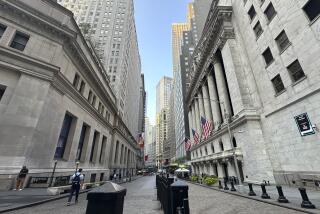Economic Indicators Up 0.8% Last Month : Best Two-Month Performance Since End of ’86
WASHINGTON — The government’s chief forecasting gauge of future economic activity shot up 0.8% in March, pointing to continued growth for the rest of the year, the Commerce Department said today.
That, combined with a revised 1.3% growth rate in February, gave the Index of Leading Economic Indicators its best back-to-back performance since the last two months of 1986, when growth rates of 0.8% and 2.2% were recorded.
February’s rate had previously been reported as a much smaller 0.9%.
The strength represented a remarkable turnaround in a forecasting gauge that at one point after the October stock market collapse was sending out signals of an impending recession.
Warning Not Infallible
When the December index number was first released, it marked the third consecutive monthly decline in the index, the traditional but not infallible warning of a recession.
But the initial calculations are subject to substantial revisions even months afterward. With today’s revision, the only declines recorded since the stock market crash were a 1.2% drop in November and a 0.7% fall in January.
Analysts said the big gains in the past two months reflect the surprising strength the economy has shown so far this year, good news for Republicans hoping to retain the White House.
“The leading index suggests the economy will be headed onward and upward as we move through the second half of the year,” said Allen Sinai, chief economist of the Boston Co. “From the point of view of the Administration, the news on the economy could hardly be better.”
New Home Sales Gain
In a separate report, the Commerce Department said sales of new homes posted a 4% gain in March, rising to an annual rate of 655,000 units, after an even better 14.1% jump in February. Analysts said the back-to-back gains showed that the housing industry has shaken off the jitters that sent sales down for several months after the October stock market collapse.
The government reported Tuesday that the gross national product grew at a moderate 2.3% annual rate from January though March, far above the declining GNP which had been feared immediately following the 508-point drop in the stock market Oct. 19.
The February and March increases in the leading index are likely to fuel growing fears, however, that the economy is expanding too rapidly and threatening to rekindle inflation.
Interest Rates Climb
Interest rates have been rising in recent days, pushed higher by investor fears that the economic strength will soon prompt the Federal Reserve to tighten up on credit conditions as a way of slowing economic activity.
The March increase in the index reflected widespread strength as six of the nine individual indicators showed gains.
The biggest gain came from a rise in stock prices followed by a drop in weekly unemployment claims.
Three indicators held the index back. The biggest negative factor was a drop in the length of the average workweek.
More to Read
Inside the business of entertainment
The Wide Shot brings you news, analysis and insights on everything from streaming wars to production — and what it all means for the future.
You may occasionally receive promotional content from the Los Angeles Times.










